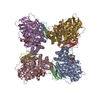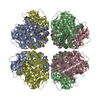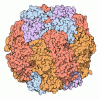[English] 日本語
 Yorodumi
Yorodumi- PDB-7qvi: Fiber-forming RubisCO derived from ancestral sequence reconstruct... -
+ Open data
Open data
- Basic information
Basic information
| Entry | Database: PDB / ID: 7qvi | |||||||||
|---|---|---|---|---|---|---|---|---|---|---|
| Title | Fiber-forming RubisCO derived from ancestral sequence reconstruction and rational engineering | |||||||||
 Components Components | RubisCO large subunit | |||||||||
 Keywords Keywords | LYASE / Ribulose 1 / 5-bisphosphate carboxylase/oxydase / RubisCO | |||||||||
| Function / homology | 2-CARBOXYARABINITOL-1,5-DIPHOSPHATE Function and homology information Function and homology information | |||||||||
| Biological species | synthetic construct (others) | |||||||||
| Method | ELECTRON MICROSCOPY / single particle reconstruction / cryo EM / Resolution: 3 Å | |||||||||
 Authors Authors | Schulz, L. / Zarzycki, J. / Prinz, S. / Schuller, J.M. / Erb, T.J. / Hochberg, G.K.A. | |||||||||
| Funding support |  Germany, 2items Germany, 2items
| |||||||||
 Citation Citation |  Journal: Science / Year: 2022 Journal: Science / Year: 2022Title: Evolution of increased complexity and specificity at the dawn of form I Rubiscos. Authors: Luca Schulz / Zhijun Guo / Jan Zarzycki / Wieland Steinchen / Jan M Schuller / Thomas Heimerl / Simone Prinz / Oliver Mueller-Cajar / Tobias J Erb / Georg K A Hochberg /   Abstract: The evolution of ribulose-1,5-bisphosphate carboxylase/oxygenases (Rubiscos) that discriminate strongly between their substrate carbon dioxide and the undesired side substrate dioxygen was an ...The evolution of ribulose-1,5-bisphosphate carboxylase/oxygenases (Rubiscos) that discriminate strongly between their substrate carbon dioxide and the undesired side substrate dioxygen was an important event for photosynthetic organisms adapting to an oxygenated environment. We use ancestral sequence reconstruction to recapitulate this event. We show that Rubisco increased its specificity and carboxylation efficiency through the gain of an accessory subunit before atmospheric oxygen was present. Using structural and biochemical approaches, we retrace how this subunit was gained and became essential. Our work illuminates the emergence of an adaptation to rising ambient oxygen levels, provides a template for investigating the function of interactions that have remained elusive because of their essentiality, and sheds light on the determinants of specificity in Rubisco. | |||||||||
| History |
|
- Structure visualization
Structure visualization
| Structure viewer | Molecule:  Molmil Molmil Jmol/JSmol Jmol/JSmol |
|---|
- Downloads & links
Downloads & links
- Download
Download
| PDBx/mmCIF format |  7qvi.cif.gz 7qvi.cif.gz | 1.2 MB | Display |  PDBx/mmCIF format PDBx/mmCIF format |
|---|---|---|---|---|
| PDB format |  pdb7qvi.ent.gz pdb7qvi.ent.gz | 1008.5 KB | Display |  PDB format PDB format |
| PDBx/mmJSON format |  7qvi.json.gz 7qvi.json.gz | Tree view |  PDBx/mmJSON format PDBx/mmJSON format | |
| Others |  Other downloads Other downloads |
-Validation report
| Arichive directory |  https://data.pdbj.org/pub/pdb/validation_reports/qv/7qvi https://data.pdbj.org/pub/pdb/validation_reports/qv/7qvi ftp://data.pdbj.org/pub/pdb/validation_reports/qv/7qvi ftp://data.pdbj.org/pub/pdb/validation_reports/qv/7qvi | HTTPS FTP |
|---|
-Related structure data
| Related structure data |  14178MC  7qsvC  7qswC  7qsxC  7qsyC  7qszC  7qt1C C: citing same article ( M: map data used to model this data |
|---|---|
| Similar structure data | Similarity search - Function & homology  F&H Search F&H Search |
- Links
Links
- Assembly
Assembly
| Deposited unit | 
|
|---|---|
| 1 |
|
- Components
Components
| #1: Protein | Mass: 51196.930 Da / Num. of mol.: 16 Source method: isolated from a genetically manipulated source Source: (gene. exp.) synthetic construct (others) Production host:  Strain (production host): ArcticExpress (DE3) #2: Sugar | ChemComp-CAP / #3: Chemical | ChemComp-MG / Has ligand of interest | Y | |
|---|
-Experimental details
-Experiment
| Experiment | Method: ELECTRON MICROSCOPY |
|---|---|
| EM experiment | Aggregation state: 2D ARRAY / 3D reconstruction method: single particle reconstruction |
- Sample preparation
Sample preparation
| Component | Name: ancestral sequence reconstruction of RubisCO large subunit in complex with CABP and Magnesium Type: COMPLEX / Details: complex of two octamers (2x L8) / Entity ID: #1 / Source: RECOMBINANT | |||||||||||||||||||||||||
|---|---|---|---|---|---|---|---|---|---|---|---|---|---|---|---|---|---|---|---|---|---|---|---|---|---|---|
| Molecular weight | Value: 0.873 MDa / Experimental value: YES | |||||||||||||||||||||||||
| Source (natural) | Organism: synthetic construct (others) | |||||||||||||||||||||||||
| Source (recombinant) | Organism:  Strain: ArtricExpress (DE3) | |||||||||||||||||||||||||
| Buffer solution | pH: 8 | |||||||||||||||||||||||||
| Buffer component |
| |||||||||||||||||||||||||
| Specimen | Conc.: 1 mg/ml / Embedding applied: NO / Shadowing applied: NO / Staining applied: NO / Vitrification applied: YES | |||||||||||||||||||||||||
| Specimen support | Grid type: Quantifoil R2/1 | |||||||||||||||||||||||||
| Vitrification | Instrument: FEI VITROBOT MARK IV / Cryogen name: ETHANE / Humidity: 100 % / Chamber temperature: 277 K |
- Electron microscopy imaging
Electron microscopy imaging
| Experimental equipment |  Model: Titan Krios / Image courtesy: FEI Company |
|---|---|
| Microscopy | Model: FEI TITAN KRIOS |
| Electron gun | Electron source:  FIELD EMISSION GUN / Accelerating voltage: 300 kV / Illumination mode: FLOOD BEAM FIELD EMISSION GUN / Accelerating voltage: 300 kV / Illumination mode: FLOOD BEAM |
| Electron lens | Mode: BRIGHT FIELD / Nominal defocus max: 2500 nm / Nominal defocus min: 500 nm |
| Image recording | Electron dose: 40 e/Å2 / Film or detector model: GATAN K3 BIOQUANTUM (6k x 4k) |
- Processing
Processing
| Software |
| ||||||||||||||||||||||||
|---|---|---|---|---|---|---|---|---|---|---|---|---|---|---|---|---|---|---|---|---|---|---|---|---|---|
| CTF correction | Type: PHASE FLIPPING AND AMPLITUDE CORRECTION | ||||||||||||||||||||||||
| 3D reconstruction | Resolution: 3 Å / Resolution method: FSC 0.143 CUT-OFF / Num. of particles: 171572 / Symmetry type: POINT | ||||||||||||||||||||||||
| Refinement | Cross valid method: NONE Stereochemistry target values: GeoStd + Monomer Library + CDL v1.2 | ||||||||||||||||||||||||
| Displacement parameters | Biso mean: 65.59 Å2 | ||||||||||||||||||||||||
| Refine LS restraints |
|
 Movie
Movie Controller
Controller


 PDBj
PDBj




